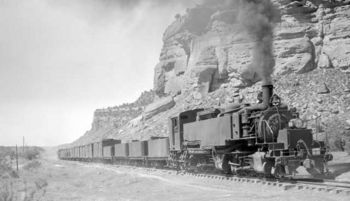Uintah Railway

The Uintah Railway was founded in 1902 as a wholly owned subsidiary of the Gilson Asphaltum Co. with the sole purpose of building a railroad into the isolated Uintah basin where the Gilson Asphaltum Co. was operating several Gilsonite mines. The route chosen would link the newly founded company town of Mack, Colorado with the mines at Dragon, Utah. The route chosen crossed 8437 ft. (2572 m) Baxter Pass with approaches characherized by grades of 7.5% (westbound) and 5% (eastbound) as well as 66 degree curves. Because of this, the railroad was built as a narrow gauge railroad. The extremely sharp curves and steep grades required the use of Shay locomotives for the steep climb up the pass, however elsewhere on the line conventional locomotives could be used. On the eastern base of Baxter Pass the railroad founded the company town of Atchee, Colorado. which served as both division point and mantenance center for the railroad. On the Western base of the pass the company built a small dam creating Lake McAndrews. Just below the lake was the water tank and a turning wye at a site named Wendella. Thus trains originating in Mack would be pulled by a conventional steam locomotive as far as Atchee; there a Shay would take the train over the pass to Wendella where a conventional steam locomotive would take the train on to Dragon and the mines.
In 1911 the Uintah Railroad expanded northward beyond Dragon to the new mining towns of Watson and Rainbow, Utah. In 1926 the railroad purchased an articulated locomotive, #50, which was specifically designed to handle the extreme curvature and steep grades of Baxter Pass. The idea was that this new locomotive would do away with the need to change engines at Atchee and Wendella. After some initial modifications, this engine proved to be such a success that in 1928 the railroad purchased a second copy, #51. These were the only narrow gauge Mallet-type articulated locomotives sold for use in the United States.
For much of the 1920s the Uintah was headed by Lucian Sprague, a railroad executive who later became well-known for orchestrating the dramatic turnaround of the bankrupt Minneapolis and St. Louis Railway.
The railroad lasted until 1939 when trucks took over hauling the Gilsonite. At that time, the rails were pulled up and the towns abandoned. Most of the railways locomotives were scrapped immediately; the two famous articulateds were sold to the Sumpter Valley Railway in Oregon, and later went to Guatemala, where they were dismantled. Today all that remains of the Uintah are the cellar pits of some of the buildings, the shell of the machine shop in Atchee, a few pieces of rolling stock, and part of the company hotel in Mack.
References
- Bender, Henry E. (1995). Uintah Railway: The Gilsonite Route. Forest Park, Illinois: Heimburger House Publishing Co.. ISBN 0-911581-36-7.
